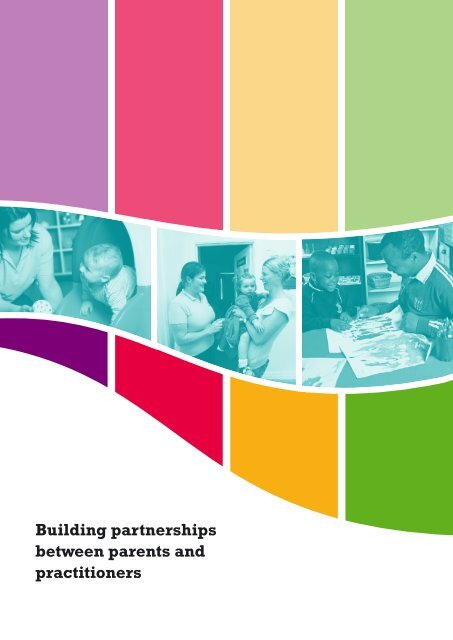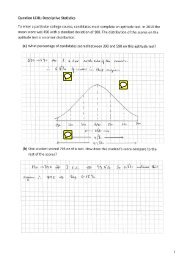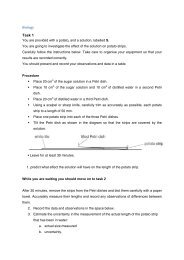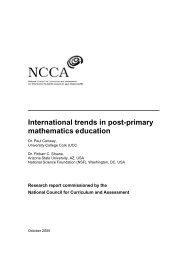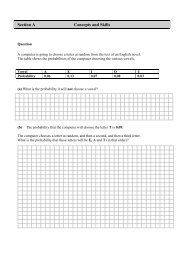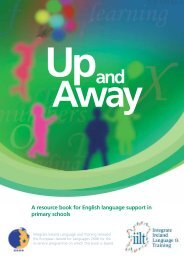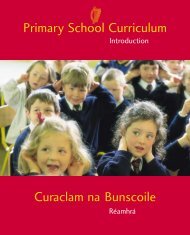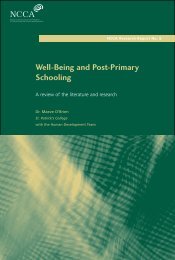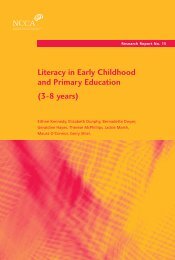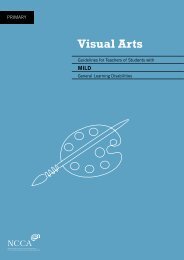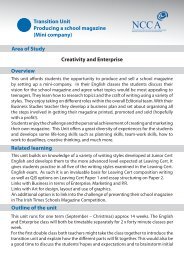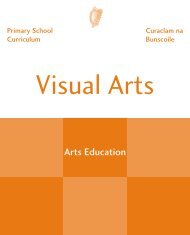Building partnerships between parents and practitioners - National ...
Building partnerships between parents and practitioners - National ...
Building partnerships between parents and practitioners - National ...
Create successful ePaper yourself
Turn your PDF publications into a flip-book with our unique Google optimized e-Paper software.
<strong>Building</strong> <strong>partnerships</strong><br />
<strong>between</strong> <strong>parents</strong> <strong>and</strong><br />
<strong>practitioners</strong>
Aistear: the Early Childhood Curriculum Framework<br />
Introduction<br />
Parents are the most important people in their children’s early lives.<br />
Children learn about the world <strong>and</strong> their place in it through their<br />
conversations, play activities, <strong>and</strong> routines with <strong>parents</strong> <strong>and</strong> families.<br />
Parents can also support children’s learning in out-of-home settings, such<br />
as childminding settings, crèches, playgroups, pre-schools, <strong>and</strong> primary<br />
schools. By working together <strong>parents</strong> <strong>and</strong> <strong>practitioners</strong> can enhance<br />
children’s learning <strong>and</strong> development.<br />
All <strong>parents</strong> need support at some time or another. For example, the loss of a<br />
loved one, a money problem, or ill health might mean that they need extra<br />
help. Time constraints, poverty, social <strong>and</strong> economic background, cultural<br />
identity, discrimination, previous negative experiences, literacy difficulties,<br />
language, or different disabilities, can also make it difficult for <strong>parents</strong><br />
to participate in their children’s learning <strong>and</strong> development as much as<br />
they might like to. While partnership can benefit all <strong>parents</strong> <strong>and</strong> families,<br />
parent/practitioner <strong>partnerships</strong> can be especially important for these<br />
families.<br />
These guidelines outline what partnership means <strong>and</strong> describe different ways in<br />
which <strong>parents</strong> <strong>and</strong> <strong>practitioners</strong> can work together.<br />
What are <strong>partnerships</strong>? Why are they important?<br />
Figure 1: Definition of partnership<br />
7<br />
<strong>Building</strong> <strong>partnerships</strong> <strong>between</strong> <strong>parents</strong> <strong>and</strong> <strong>practitioners</strong><br />
Partnership involves <strong>parents</strong>, families <strong>and</strong> <strong>practitioners</strong> working together to benefit children. Each<br />
recognises, respects <strong>and</strong> values what the other does <strong>and</strong> says. Partnership involves responsibility on<br />
both sides.<br />
Increasingly, the early care <strong>and</strong> education of babies, toddlers <strong>and</strong> young<br />
children is shared among <strong>parents</strong>, families <strong>and</strong> <strong>practitioners</strong>. A partnership<br />
approach <strong>between</strong> these people is very important, especially at times<br />
of change in children’s lives. These times might include settling in to a<br />
new setting, getting to know a new practitioner, or getting used to a new<br />
baby at home. Other critical times might be when children experience<br />
bereavement, are upset or worried, or feel left out or different in a<br />
negative way. By working together <strong>and</strong> sharing information <strong>parents</strong><br />
<strong>and</strong> <strong>practitioners</strong> can help make these times in children’s lives easier.<br />
Good <strong>partnerships</strong> are built on trust. Practitioners need to respect the confidentiality of<br />
information they receive about children, while underst<strong>and</strong>ing that confidentiality cannot be guaranteed for<br />
example in cases involving child protection issues. 1<br />
Table 1 outlines the benefits of good <strong>partnerships</strong> for <strong>parents</strong>, <strong>practitioners</strong> <strong>and</strong> children.<br />
1<br />
See Children First: <strong>National</strong> Guidelines for the Protection of Children (Department of Health <strong>and</strong> Children, 1999), Our Duty to Care: the principles<br />
of good practice for the protection of children <strong>and</strong> young people, (Department of Health <strong>and</strong> Children, 2002) <strong>and</strong> Child Protection—Guidelines <strong>and</strong><br />
Procedures (Department of Education <strong>and</strong> Science, 2001).
Aistear: the Early Childhood Curriculum Framework<br />
Table 1: The benefits of <strong>parents</strong> <strong>and</strong> <strong>practitioners</strong> working together<br />
Parents Practitioners Children<br />
■■<br />
■■<br />
■■<br />
■■<br />
■■<br />
■■<br />
■■<br />
■■<br />
feel valued <strong>and</strong> respected<br />
are more involved in their children’s<br />
learning <strong>and</strong> development<br />
can share information about their<br />
children<br />
feel their family’s values, practices,<br />
traditions, <strong>and</strong> beliefs are<br />
understood <strong>and</strong> taken into account<br />
feel comfortable visiting the setting,<br />
talking to, <strong>and</strong> planning with<br />
<strong>practitioners</strong><br />
know more about their children’s<br />
experiences outside the home <strong>and</strong><br />
use this information to support<br />
their learning <strong>and</strong> development<br />
more effectively<br />
underst<strong>and</strong> why early childhood<br />
care <strong>and</strong> education is important<br />
have increased confidence in their<br />
own parenting skills.<br />
Partnership in action<br />
■■<br />
■■<br />
■■<br />
■■<br />
underst<strong>and</strong> better the children <strong>and</strong><br />
families in their settings <strong>and</strong> use<br />
this information to make learning<br />
more enjoyable <strong>and</strong> rewarding for<br />
all children<br />
can help children develop a sense<br />
of identity <strong>and</strong> belonging in the<br />
setting by actively engaging with<br />
<strong>and</strong> finding out about family values,<br />
traditions <strong>and</strong> beliefs, <strong>and</strong> building<br />
on these where appropriate<br />
benefit from <strong>parents</strong>’ skills <strong>and</strong><br />
expertise<br />
can provide a more emotionally<br />
secure environment for children.<br />
8<br />
<strong>Building</strong> <strong>partnerships</strong> <strong>between</strong> <strong>parents</strong> <strong>and</strong> <strong>practitioners</strong><br />
■■<br />
■■<br />
■■<br />
■■<br />
■■<br />
feel more secure <strong>and</strong> benefit more<br />
from the educational opportunities<br />
given to them<br />
move from one setting to another<br />
with greater confidence<br />
see learning as more enjoyable<br />
when their home life is ‘visible’ in<br />
the setting<br />
enjoy hearing <strong>and</strong> seeing their home<br />
language in the setting when their<br />
home language is neither English<br />
nor Irish<br />
experience more connections<br />
<strong>between</strong> the different services that<br />
support them.<br />
There are many different ways in which <strong>parents</strong> <strong>and</strong> <strong>practitioners</strong> can work together. These guidelines focus<br />
on four:<br />
■■<br />
■■<br />
■■<br />
■■<br />
supporting learning <strong>and</strong> development<br />
sharing information<br />
contributing<br />
making decisions <strong>and</strong> advocating different approaches <strong>and</strong> courses of action.<br />
There are connections across these different ways as can be seen in a number of the learning experiences on<br />
pages 11 to 25.<br />
Supporting learning <strong>and</strong> development<br />
Parenting involves giving children the care, education <strong>and</strong> attention they need to learn <strong>and</strong> develop. Parents<br />
provide children with their first learning experiences <strong>and</strong> they help ensure that children reach important<br />
developmental milestones such as sitting, walking, becoming toilet-trained, talking, cutting, doing up buttons,<br />
cycling, reading, <strong>and</strong> so on. As children go on to spend time in out-of-home settings <strong>parents</strong> continue<br />
to support their learning <strong>and</strong> development. This is more effective when <strong>parents</strong> complement children’s<br />
experiences in a particular setting. Likewise, learning is more meaningful when <strong>practitioners</strong> use information<br />
from <strong>parents</strong> about children’s interests, skills, abilities, <strong>and</strong> dispositions as a starting point for new<br />
experiences. Below are some ways in which <strong>parents</strong> can support their children’s learning <strong>and</strong> development at<br />
home, <strong>and</strong> how <strong>practitioners</strong> can help them to do this.
Aistear: the Early Childhood Curriculum Framework<br />
Parents<br />
9<br />
<strong>Building</strong> <strong>partnerships</strong> <strong>between</strong> <strong>parents</strong> <strong>and</strong> <strong>practitioners</strong><br />
You can support your child’s learning <strong>and</strong> development at home in the following ways:<br />
■■ Ask the practitioner for suggestions for what you can do at home with your child.<br />
■■ Involve your child in everyday activities like cooking, shopping, working in the garden, going to the<br />
launderette, <strong>and</strong> travelling on the bus. Talk to your child about what he/she is doing, sees, <strong>and</strong> how<br />
he/she feels.<br />
■■ Give your child opportunities to use his/her senses—to see, smell, taste, touch, <strong>and</strong> hear different things.<br />
■ ■ Read to your child. Join your local library, <strong>and</strong> help your child to choose books to enjoy together.<br />
■ ■ Sing songs, tell stories <strong>and</strong> play games with your child. Have fun together.<br />
■ ■ Talk to your child. Encourage him/her to ask questions. Let your child know you don’t always have the<br />
answer. Find things out together.<br />
■■ Limit the amount of time your child spends watching television. Talk to him/her about what he/she watches.<br />
■■ Find out how children learn <strong>and</strong> develop. Ask your child’s practitioner about useful books or websites<br />
for information.<br />
■■ Look at Aistear: the Early Childhood Curriculum Framework for ideas about what you can do to support<br />
your child’s learning <strong>and</strong> development. The sample learning opportunities in the four themes <strong>and</strong> the<br />
learning experiences in the guidelines suggest lots of activities that you can do together.<br />
Practitioners<br />
You can help <strong>parents</strong> to support their children’s learning <strong>and</strong> development in the following ways:<br />
■ ■ Share information about the curriculum with <strong>parents</strong>.<br />
➜■<br />
Use a notice-board to let <strong>parents</strong> know what activities children do on a particular day. Pictures<br />
might be useful in sharing this information with <strong>parents</strong> who have little English or Irish.<br />
➜■<br />
➜■<br />
➜■<br />
➜■<br />
Send home photographs of the children with captions which describe what they have been doing<br />
<strong>and</strong> learning.<br />
Let <strong>parents</strong> know about topics that interest their children. Find out what their interests are at home<br />
<strong>and</strong> build on these.<br />
Invite <strong>parents</strong> to share information about their culture <strong>and</strong> traditions that might be useful in<br />
supporting their children’s learning <strong>and</strong> development.<br />
Organise information sessions for <strong>parents</strong>. Some of these might be especially important before<br />
<strong>and</strong>/or after children join the setting. A session might focus on Aistear’s four themes <strong>and</strong> what you<br />
do to support children’s learning <strong>and</strong> development in these. In the case of children in junior <strong>and</strong><br />
senior infants, the information session might focus on the Primary School Curriculum <strong>and</strong> Aistear.<br />
Another session might highlight the importance of play <strong>and</strong> how children can learn through it.
Aistear: the Early Childhood Curriculum Framework<br />
10<br />
<strong>Building</strong> <strong>partnerships</strong> <strong>between</strong> <strong>parents</strong> <strong>and</strong> <strong>practitioners</strong><br />
➜■ Meet with the infant class teacher(s) to find out how you can help <strong>parents</strong> <strong>and</strong> their children move<br />
on to primary school with confidence, ease <strong>and</strong> excitement.<br />
➜■ Give <strong>parents</strong> the address of the NCCA website so that they can find out more about Aistear: the<br />
Early Childhood Curriculum Framework (see www.ncca.ie/earlylearning).<br />
■■ Share resources with <strong>parents</strong>.<br />
➜■ Make leaflets, tip sheets, DVDs, <strong>and</strong> other resources available to <strong>parents</strong>. Provide these in children’s<br />
home languages where possible.<br />
➜■ Lend story books <strong>and</strong> tapes of songs <strong>and</strong> rhymes.<br />
➜■ Make learning kits with ideas for activities, <strong>and</strong> include items like chubby crayons <strong>and</strong> safety<br />
scissors if funds allow.<br />
➜■ Share easy-to-read books on child development.<br />
■■ Invite <strong>parents</strong> to spend time in the setting so that they can join in with activities <strong>and</strong> learn about what<br />
their children do.<br />
■■ Develop a regular newsletter that provides useful information such as the words of songs <strong>and</strong> rhymes<br />
that the children are learning, important dates, updates on policies, <strong>and</strong> snippets of theory followed by<br />
ideas for activities to do at home that are fun <strong>and</strong> don’t cost much.<br />
Thinking about my practice<br />
As a parent<br />
1. What new <strong>and</strong> fun activities can I do with my child to help him/her learn <strong>and</strong> develop?<br />
2. How much do I know about what my child is learning in the out-of-home setting?<br />
3. How can I find out more about how to support his/her learning <strong>and</strong> development at<br />
home?<br />
As a practitioner<br />
4. How can I gather <strong>and</strong> use information from <strong>parents</strong> to improve children’s experiences?<br />
5. What steps can I take to help <strong>parents</strong> support their children’s learning <strong>and</strong><br />
development?<br />
6. What resources do I have that I could share with <strong>parents</strong>?
Aistear: the Early Childhood Curriculum Framework<br />
Learning experience 1: Jack’s New Zeal<strong>and</strong> roots<br />
11<br />
<strong>Building</strong> <strong>partnerships</strong> <strong>between</strong> <strong>parents</strong> <strong>and</strong> <strong>practitioners</strong><br />
Theme: Exploring <strong>and</strong> Thinking, Aim 1 <strong>and</strong> Learning goal 5<br />
Age group: Babies <strong>and</strong> young children<br />
Setting: Home <strong>and</strong> childminding<br />
Every evening Luke reads a bedtime story to his son Jack (5½ years) <strong>and</strong> his baby daughter Kate (16<br />
months). As they snuggle up to their Daddy, Kate helps to turn the pages <strong>and</strong> points to her favourite<br />
characters. She loves ‘lift the flap’ books <strong>and</strong> Luke told Kate’s childminder, Mags, about this when she<br />
was starting with Mags a few months ago. Mags has a number of these books <strong>and</strong> Kate loves to sit on<br />
her knee on the garden seat looking at them.<br />
Luke also told Mags about Jack’s interest in books, especially books about sport. Luke is originally from<br />
New Zeal<strong>and</strong> <strong>and</strong> he <strong>and</strong> Jack love to read about rugby. Jack has taught the other children at Mags’ to<br />
play rugby, <strong>and</strong> a few weeks ago Luke arranged for Mags <strong>and</strong> the four children she minds to go to a<br />
local school rugby match. She also purchased two books about New Zeal<strong>and</strong> as Jack <strong>and</strong> his family are<br />
planning a trip there during the summer to visit his gr<strong>and</strong><strong>parents</strong>. The children <strong>and</strong> Mags are learning<br />
a lot about New Zeal<strong>and</strong>. They are finding out about the weather, the sports people play, the food they<br />
eat, <strong>and</strong> the types of farms they have. They are also comparing these with the village in Co. Tipperary<br />
where they live. The children are really excited about Jack <strong>and</strong> his family flying on a huge aeroplane.<br />
They are even building one just like it in Mags’ playroom. It’s massive!<br />
Reflection: How can I build on children’s interests to enhance their learning <strong>and</strong> development, <strong>and</strong> to<br />
strengthen their sense of identity?<br />
Learning experience 2: The beat of the drum<br />
Theme: Identity <strong>and</strong> Belonging, Aim 2 <strong>and</strong> Learning goal 2<br />
Age group: Toddlers<br />
Setting: Home <strong>and</strong> full <strong>and</strong> part-time daycare (crèche)<br />
Gloria moved to Irel<strong>and</strong> from North Nigeria three years ago. She speaks English <strong>and</strong> helps out in the<br />
toddler room on a Tuesday morning every two weeks. Her gr<strong>and</strong>son Lee (2½ years) has been attending<br />
the crèche since September <strong>and</strong> is in the toddler room. On each visit, Gloria brings along something<br />
from North Nigeria for the children to see, play with, <strong>and</strong> learn about. These items are all familiar to<br />
Lee. Today she brings an African drum. She plays it while she sings an African song. The children gather<br />
round her. Some sway <strong>and</strong> some clap while others dance to the beat. Lee <strong>and</strong> some of his friends join<br />
in with some of the repeated words <strong>and</strong> phrases. Afterwards, the children take turns to play the drum.<br />
Next time, Gloria plans to play some outdoor games with the toddlers. Sorcha, the room leader, takes a<br />
few minutes of video which she shows the children after Gloria goes home.<br />
Reflection: In what ways can I involve <strong>parents</strong> <strong>and</strong> gr<strong>and</strong><strong>parents</strong> in giving the children rich<br />
experiences?
Aistear: the Early Childhood Curriculum Framework<br />
Learning experience 3: Helping me to learn<br />
Theme: Communicating, Aim 3 <strong>and</strong> Learning goal 2<br />
Age group: Young children<br />
Setting: Home <strong>and</strong> infant class (primary school)<br />
12<br />
<strong>Building</strong> <strong>partnerships</strong> <strong>between</strong> <strong>parents</strong> <strong>and</strong> <strong>practitioners</strong><br />
Kara (4 years) is in junior infants. Her <strong>parents</strong> left school early. They have difficulties with literacy <strong>and</strong><br />
know this is a disadvantage. They really want Kara to do well in school <strong>and</strong> to get a good education. But<br />
Kara says she doesn’t like school. Kara <strong>and</strong> her family have the support of a Home School Community<br />
Liaison co-ordinator, Betty. Betty encourages Kara’s <strong>parents</strong> to talk to her teacher, Ms. Nugent, <strong>and</strong> she<br />
suggests some questions they might ask. Ms. Nugent encourages them to help Kara in whatever way<br />
they can. She suggests that they use a picture book to read a story or to tell her stories themselves<br />
about when they were children. They can draw pictures together at home <strong>and</strong> talk about them. If they<br />
have time they can come in some days <strong>and</strong> help out in the classroom.<br />
Ms. Nugent also encourages Kara in school by asking her what kind of books she likes to look at <strong>and</strong><br />
read. Kara replies, Books about babies are good <strong>and</strong> books about dressing up <strong>and</strong> going to<br />
my friend’s house. Ms. Nugent regularly uses books on these topics when reading stories to Kara<br />
<strong>and</strong> her friends. She puts dress-up clothes <strong>and</strong> props such as tiaras, dolls, buggies, <strong>and</strong> h<strong>and</strong>-bags in<br />
the pretend play area. Ms. Nugent regularly talks to Kara’s mam to see how they can continue to work<br />
together to support Kara at home <strong>and</strong> in school. Betty also liaises with Ms. Nugent <strong>and</strong> Kara’s <strong>parents</strong><br />
regularly to ensure Kara <strong>and</strong> her family have positive school experiences.<br />
Reflection: What can I do to give extra support <strong>and</strong> encouragement to some <strong>parents</strong>?<br />
Sharing information<br />
Good communication <strong>between</strong> <strong>parents</strong> <strong>and</strong> <strong>practitioners</strong> is key to<br />
promoting children’s learning <strong>and</strong> development. Each person needs<br />
to be clear about the role <strong>and</strong> expectations of the other person. As<br />
noted earlier, it is important that everyone underst<strong>and</strong>s that some<br />
information shared by <strong>parents</strong> <strong>and</strong> <strong>practitioners</strong> is confidential<br />
although not in the case of child protection issues.<br />
Some <strong>parents</strong> may have specific needs in accessing information or<br />
participating in activities. For example, <strong>parents</strong> who have physical<br />
disabilities, sensory impairments, literacy difficulties, whose home<br />
language is different from that of the setting need information in an<br />
accessible form. Parents themselves are the most valuable resource<br />
in building a partnership relationship. However, some <strong>parents</strong> may<br />
be shy or lack confidence, but with a little encouragement they may<br />
be happy to get involved. Getting to know them, their needs <strong>and</strong><br />
their expectations, is the first step, as <strong>parents</strong> can offer valuable<br />
insights into how services can be improved or made more accessible<br />
for them.<br />
Partnership <strong>between</strong> <strong>practitioners</strong> <strong>and</strong> other professionals who are<br />
involved in supporting children’s learning <strong>and</strong> development is also<br />
vital, so that their inputs benefit children as much as possible. When<br />
direct contact <strong>between</strong> <strong>practitioners</strong> <strong>and</strong> other professionals is not<br />
possible <strong>parents</strong> can often act as a link <strong>and</strong> pass on information.
Aistear: the Early Childhood Curriculum Framework<br />
The setting<br />
13<br />
<strong>Building</strong> <strong>partnerships</strong> <strong>between</strong> <strong>parents</strong> <strong>and</strong> <strong>practitioners</strong><br />
Parents should be given information about their children’s out-of-home setting <strong>and</strong> the staff. This information 2<br />
includes details of<br />
■■<br />
■■<br />
■■<br />
■■<br />
■■<br />
■■<br />
■■<br />
■■<br />
■■<br />
the setting’s vision or mission<br />
the curriculum—its principles, what children learn <strong>and</strong> how<br />
the manager/principal, <strong>and</strong> the primary contact person <strong>and</strong>/or the child’s key worker<br />
the setting’s facilities<br />
opening <strong>and</strong> closing times<br />
staff training <strong>and</strong> qualifications<br />
adult/child ratios, <strong>and</strong> the maximum numbers <strong>and</strong> age range of the children<br />
fees<br />
policies on areas such as managing behaviour, promoting healthy eating, giving first-aid, <strong>and</strong> settling in.<br />
Children’s experiences <strong>and</strong> progress<br />
Parents <strong>and</strong> <strong>practitioners</strong> need to communicate regularly about children’s progress, interests, needs, <strong>and</strong><br />
daily experiences. Parents have a wealth of information about their children. Sharing this information with<br />
<strong>practitioners</strong> helps build a more complete picture of what children can do—their likes, dislikes, interests,<br />
<strong>and</strong> so on. It is important, therefore, that <strong>parents</strong> have opportunities to meet with <strong>practitioners</strong> <strong>and</strong><br />
share information about their children. For more information see the guidelines, Supporting learning <strong>and</strong><br />
development through assessment.<br />
Parents often talk with people from different professions about their children, <strong>and</strong> each profession can<br />
have its own specialised language. Even everyday terms can have different meanings in different situations.<br />
It is important that everyone underst<strong>and</strong>s what is being discussed, what terms mean, <strong>and</strong> what is being<br />
suggested for children. This is important for all children, but especially when <strong>parents</strong>’ or the practitioner’s<br />
first language is neither English nor Irish, when <strong>parents</strong> have little or no formal education, <strong>and</strong>, in the case of<br />
children with special educational needs, when technical terms may be used.<br />
Information should be shared in plain English/Irish. Writing notes, talking, using pictures, <strong>and</strong> translating<br />
information are all helpful ways of communicating with <strong>parents</strong>. Different arrangements may be needed for<br />
different families. Practitioners need to be particularly mindful of <strong>parents</strong> who are separated or divorced<br />
when thinking about communication. The information may need to be sent to two different homes <strong>and</strong><br />
separate appointments may need to be made to talk to the <strong>parents</strong>. Different arrangements work in different<br />
situations.<br />
2<br />
The Child Care (Pre-School Services) Regulations (2006) set out the basic information that <strong>parents</strong> must be given. Many settings like to share more<br />
information than this about the way they work.
Aistear: the Early Childhood Curriculum Framework<br />
Parents: Sharing information with your child’s practitioner<br />
14<br />
<strong>Building</strong> <strong>partnerships</strong> <strong>between</strong> <strong>parents</strong> <strong>and</strong> <strong>practitioners</strong><br />
■■ Get to know your child’s practitioner. Show your interest in hearing about your child’s experiences. Talk<br />
to the practitioner regularly when dropping off or collecting your child. Where this may not be possible<br />
make an appointment or use a note or a diary to share information.<br />
■■ Give the practitioner feedback. For example, tell him/her when your child comes home excited about an<br />
activity <strong>and</strong> wants to try it out at home.<br />
■■ Tell the practitioner about your child’s achievements at home.<br />
■■ Share your family traditions <strong>and</strong> culture so that the practitioner can help your child feel he/she belongs<br />
in the setting. Let <strong>practitioners</strong> know about your childrearing practices, especially when these may differ<br />
from those in the setting.<br />
■■ Tell the practitioner about anything that might be affecting your child’s mood or behaviour, such as the<br />
death of a pet, a sick parent, a separation, as well as about exciting events at home such as a birthday, a<br />
cultural event, a new pet, or a visit from a cousin.<br />
■■ Look at displays of your child’s work or photographs of him/her in the setting. Talk to your child about<br />
these.<br />
■■ Share concerns you may have about your child’s learning <strong>and</strong> development with the practitioner.<br />
■■ Share information about particular supports or help you or your child need in order to participate<br />
in activities. Share specialist knowledge about your child’s needs with the practitioner. Pass on<br />
recommendations or suggestions that specialist services have made about your child. For example, if the<br />
physiotherapist has recommended exercises to improve your child’s upper body strength make sure that<br />
the practitioner knows about these.<br />
■■ Let the practitioner know if you would like more information about the setting <strong>and</strong> about how you<br />
would like to receive that information. If there is something that you are not clear about or that you are<br />
concerned about, ask.<br />
■■ Offer to help with translation, or in other ways, to help other <strong>parents</strong> who use the setting.<br />
Practitioners: Sharing information with <strong>parents</strong><br />
■■ Where possible talk informally to <strong>parents</strong> on a regular basis as well as at parent/practitioner meetings.<br />
Encourage them to come to you for information.<br />
■■ Share examples of children’s work with <strong>parents</strong> <strong>and</strong> families. For example, make portfolios of the<br />
children’s work. Organise open days <strong>and</strong> exhibitions to display <strong>and</strong> celebrate these. Send the portfolios<br />
home at the end of a month, term or year. Display children’s work <strong>and</strong> photographs in hallways <strong>and</strong><br />
change these regularly.<br />
■■ Make sure that displays reflect the diversity of the families who use the service, including family<br />
structure, disability, Traveller, <strong>and</strong> new community. (See the theme, Identity <strong>and</strong> Belonging.)<br />
■■ Provide information <strong>and</strong> feedback verbally as well as in writing, <strong>and</strong> in children’s home languages<br />
where possible. Use email as well as printed notices, h<strong>and</strong>outs <strong>and</strong> newsletters. Use text messages to<br />
remind <strong>parents</strong> about special events, <strong>and</strong> leave details on voice mail or answering machines that can be<br />
accessed at weekends <strong>and</strong> holidays.<br />
■■ Share records with <strong>parents</strong>, in addition to the statutory minimum requirements under the Child Care<br />
(Pre-School Services) Regulations (Department of Health <strong>and</strong> Children, 2006). For example, a crèche or<br />
childminder might keep a daily notebook recording the baby’s or toddler’s physical care (bottles, meals,<br />
nappies) <strong>and</strong> achievements such as smiles, new words, friendships, <strong>and</strong> so on. It is important that<br />
<strong>practitioners</strong> are honest with <strong>parents</strong> <strong>and</strong> let them know about problems <strong>and</strong> issues of concern, as well<br />
as progress <strong>and</strong> achievements, as early as possible. This needs to be done in person. (See the guidelines,<br />
Supporting learning <strong>and</strong> development through assessment.)
Aistear: the Early Childhood Curriculum Framework<br />
15<br />
<strong>Building</strong> <strong>partnerships</strong> <strong>between</strong> <strong>parents</strong> <strong>and</strong> <strong>practitioners</strong><br />
■■ Some <strong>parents</strong> may need help to interpret report cards when these are used, for example in primary<br />
schools. Including definitions of words or using graphics on the cards could help with this.<br />
■■ Let <strong>parents</strong> know that there is a regular time when a staff member is available to talk on the phone. This<br />
might be especially helpful for <strong>parents</strong> who are at work during the day or have difficulty in coming in to<br />
the setting. However, it is generally better to have face-to-face discussions, especially if there is a problem.<br />
■■ Hold workshops on children’s learning <strong>and</strong> development, for example on learning through play. Give<br />
<strong>parents</strong> h<strong>and</strong>s-on experience of some of the activities. Inform them of the social <strong>and</strong> emotional aspects of<br />
learning, <strong>and</strong> help them to see the importance of play <strong>and</strong> active exploration.<br />
■■ Organise a variety of activities for <strong>parents</strong> at different times of the day <strong>and</strong> week to include as many<br />
<strong>parents</strong> as possible. For example, organise a crèche to allow <strong>parents</strong> of younger children to attend a<br />
meeting or another event. Ensure that people with mobility problems, literacy problems <strong>and</strong> sensory<br />
impairment can take part.<br />
■■ Make a special effort to include dads. <strong>Building</strong> a relationship with them as they drop off <strong>and</strong>/or collect<br />
their children might help to encourage them to get more involved in their children’s learning <strong>and</strong><br />
development, <strong>and</strong> to come along to activities <strong>and</strong> meetings in the setting. Providing a crèche facility might<br />
encourage <strong>and</strong> enable both <strong>parents</strong> to attend a meeting or social event.<br />
■■ Arrange social events for <strong>parents</strong> to help them to meet <strong>and</strong> build support networks with other <strong>parents</strong> as<br />
well as with <strong>practitioners</strong>.<br />
■■ Collaborate with local adult education groups <strong>and</strong> encourage <strong>parents</strong> to participate in adult learning<br />
initiatives which can help to build <strong>parents</strong>’ confidence in their own literacy <strong>and</strong> numeracy skills <strong>and</strong> in<br />
using the home as a learning environment.<br />
Thinking about my practice<br />
As a parent<br />
1. What information can I share with the practitioner that will help him/her to get a<br />
clearer picture of what my child’s interests <strong>and</strong> strengths are?<br />
2. Do I share my concerns with the practitioner? How could I do this better?<br />
3. How can I use the written <strong>and</strong> oral feedback I get on my child’s learning?<br />
4. Have I told the setting of any difficulties I have with attending events or accessing<br />
information?<br />
5. What could I do to help other <strong>parents</strong> to get involved?<br />
As a practitioner<br />
6. How can I improve how I communicate with all <strong>parents</strong> about their children?<br />
7. How can I make better use of the feedback <strong>and</strong> information that I get from <strong>parents</strong><br />
about their children?<br />
8. In what ways can I share my knowledge with <strong>parents</strong> about how children learn <strong>and</strong><br />
develop?<br />
9. When I invite <strong>parents</strong> to events, how can I make it easier for them to attend, in terms<br />
of timing, accessible information, crèche facilities?
Aistear: the Early Childhood Curriculum Framework<br />
Learning experience 4: An open-door policy<br />
Theme: Well-being, Aim 1 <strong>and</strong> Learning goal 3<br />
Age group: Toddlers <strong>and</strong> young children<br />
Setting: Home <strong>and</strong> sessional service (playgroup)<br />
16<br />
<strong>Building</strong> <strong>partnerships</strong> <strong>between</strong> <strong>parents</strong> <strong>and</strong> <strong>practitioners</strong><br />
Mina greets the children <strong>and</strong> their <strong>parents</strong> as they arrive at the playgroup every morning. She finds these<br />
few minutes of contact invaluable. Parents can let her know if they would like more time to chat about<br />
their children <strong>and</strong> she arranges a time to suit. At the beginning of the year she also lets them know that<br />
she can be contacted by phone every day from 1 p.m. to 1.30 p.m. if they have any concerns, or just<br />
want to chat about how their child is getting on in the playgroup. She reminds them of this regularly,<br />
<strong>and</strong> many of them find it reassuring that they can keep in touch like this. Some children are brought by<br />
relatives or childminders, <strong>and</strong> this form of contact is invaluable for their <strong>parents</strong> as they can ring Mina<br />
during their lunchtime.<br />
Mikie (2 years <strong>and</strong> 11 months) started in the playgroup a month ago. His mam, Lucy, is very shy <strong>and</strong><br />
Mina makes a special effort to have a chat with her once a week. Mina shows Lucy something, such as<br />
a photograph of him playing or a picture that Mikie has made. She uses this to encourage Lucy to talk<br />
about Mikie. She asks about things he likes to do at home <strong>and</strong> she offers ideas to Lucy to help extend<br />
what he is learning in the setting.<br />
Reflection: What strategies could I use to help <strong>parents</strong> to feel more confident in talking to me about<br />
their children?<br />
Learning experience 5: The newsletter<br />
Theme: Exploring <strong>and</strong> Thinking, Aim 4 <strong>and</strong> Learning goal 3<br />
Age group: Toddlers <strong>and</strong> young children<br />
Setting: Home <strong>and</strong> full <strong>and</strong> part-time daycare (nursery)<br />
The staff of the Happy Start Nursery have made a welcome pack for <strong>parents</strong> of new children. The pack<br />
includes the nursery’s mission statement <strong>and</strong> information about how the staff support children’s<br />
learning <strong>and</strong> development. They also send home a short newsletter each month so that <strong>parents</strong> know<br />
what songs, stories <strong>and</strong> activities the children are doing. Children are involved in deciding what<br />
information is included. An example of a recent newsletter available in English, French <strong>and</strong> Polish (the<br />
main home languages of the children) is included below. The staff also plan to use text messages for<br />
<strong>parents</strong> who want to receive reminders about events in the nursery.<br />
Reflection: How can I share more information with <strong>parents</strong> about what their children are doing in my<br />
setting?
Aistear: the Early Childhood Curriculum Framework<br />
Doing Great Things Together!<br />
17<br />
<strong>Building</strong> <strong>partnerships</strong> <strong>between</strong> <strong>parents</strong> <strong>and</strong> <strong>practitioners</strong><br />
Happy Start Nursery: Senior toddlers <strong>and</strong> pre-schoolers<br />
Our day out in the woods!<br />
May 2009<br />
A big thank you to all the <strong>parents</strong> who came with us on our trip to Glengarra woods. A great day was<br />
had by all. The children tell us that they enjoyed the trip on the bus <strong>and</strong> the picnic the best! They<br />
also loved splashing in the puddles in their wellies. Since our return we have been learning about the<br />
trees <strong>and</strong> flowers that grow in the woods. We have also begun to learn about making honey since we<br />
discovered the bee hives hidden in the corner of the woods. Mr Mackey, who supplies honey to the local<br />
shops, is visiting the pre-school on June 12. He will bring some honey <strong>and</strong> show a video of the bees.<br />
Why not join us at 10 a.m. that day?<br />
Photos of the Glengarra trip are on display in the main hall.<br />
Time for more stories<br />
We are going to the library as usual on the last Friday of this month. Thanks to the <strong>parents</strong> who came<br />
with us last month.<br />
Have you spotted our bus?<br />
Since the children enjoyed the trip on the bus to Glengarra Wood so much we decided to make our own<br />
bus. Thanks to Darren’s daddy who gave us some lovely big cardboard boxes to work with. After much<br />
hard work we now have our own colourful buses complete with steering wheels, horns <strong>and</strong> seats. To<br />
build on the topic of transport Ava’s mam Nora is coming in next week to talk to us about her job as the<br />
driver of the primary school bus. Many of the children in the pre-school will be travelling on this bus<br />
when they start school in September. Nora will be here at 10.30 on Thursday morning May 14. Come<br />
along if you can <strong>and</strong> stay for a cup of tea/coffee afterwards in the parent room.<br />
Rhymes<br />
As you know we always include a nursery rhyme or a poem in our newsletter. This month the children<br />
asked us to give you the words of the song, The Wheels on the bus. They’ll teach you the actions. Hope<br />
you enjoy it.<br />
■■<br />
■■<br />
■■<br />
■■<br />
■■<br />
■■<br />
■■<br />
■■<br />
■■<br />
The wheels on the bus go round <strong>and</strong> round, round <strong>and</strong> round,<br />
round <strong>and</strong> round,<br />
The wheels on the bus go round <strong>and</strong> round, All through the town.<br />
The wipers on the bus go swish, swish, swish …<br />
The doors on the bus go open <strong>and</strong> shut …<br />
The horn on the bus goes beep, beep, beep …<br />
The gas on the bus goes glug, glug, glug …<br />
The money on the bus goes clink, clink, clink …<br />
The people on the bus go chatter, chatter, chatter …<br />
The wheels on the bus go round <strong>and</strong> round …<br />
Look who has a birthday in May<br />
Rarish Obert will be 2 on May 1st.<br />
Sharon O’Brien will be 3 on May 7th.<br />
Fiachra Long will be 4 on May 15th.<br />
Kia Mihas will be 5 on May 17th.<br />
We hope you all have a lovely birthday.<br />
Important date for your diary<br />
During the first two weeks in June we hope to meet you <strong>and</strong> your child for a short while. Your child will<br />
show you his/her portfolio so you can see what he/she has been doing <strong>and</strong> learning through the year. If<br />
the time <strong>and</strong> date don’t suit please contact Michelle on 084 6655437.
Aistear: the Early Childhood Curriculum Framework<br />
Learning experience 6: Paul’s daily diary<br />
18<br />
<strong>Building</strong> <strong>partnerships</strong> <strong>between</strong> <strong>parents</strong> <strong>and</strong> <strong>practitioners</strong><br />
Theme: Identity <strong>and</strong> Belonging, Aim 1 <strong>and</strong> Learning goal 5<br />
Age group: Young children<br />
Setting: Home <strong>and</strong> infant class (special primary school)<br />
Paul (5 years) has moderate general learning disabilities. He goes on a bus every morning to attend<br />
Holy Angels’ Special School seventeen miles from home. His <strong>parents</strong> rarely visit his school because<br />
of the distance, so they <strong>and</strong> his teacher use a daily diary to keep each other up-to-date on how Paul is<br />
getting on. This means that his <strong>parents</strong> can talk to him about what happens at school <strong>and</strong> can reinforce<br />
his learning at home. It also means that his <strong>practitioners</strong> are able to take what happens at home into<br />
account, as Paul has difficulty communicating this himself.<br />
Paul was very excited recently when his family got a new puppy. His mam wrote about this in his diary.<br />
His teacher used this information when planning his activities for the week. Paul screeched excitedly<br />
when Miss O’Malley knew the name of the puppy <strong>and</strong> he seemed to really enjoy it when she read him<br />
a story about a sheepdog working on a farm. An example of an extract from Paul’s diary is included<br />
below.<br />
Reflection: What special arrangements can I put in place to share information with <strong>parents</strong> I don’t<br />
often see?<br />
Figure 2: Extract from Paul’s daily diary<br />
February 28<br />
Hi Fiona<br />
Paul had a poor night’s sleep. Seemed fine when he came home from school. Had his tea <strong>and</strong> we went for a<br />
walk with him in the wheelchair. Toby, the puppy came too. As usual Paul had his bath <strong>and</strong> we read him a<br />
story but for some reason he never settled. He may be tired in school today. I know I am!<br />
Regards<br />
Aileen<br />
February 28<br />
Thanks Aileen. Jackie, Paul’s physio did a session with him today. I told her he might be a little tired. She<br />
did some gentle exercises with him <strong>and</strong> when she brought him back to class he seemed very tired so we put<br />
him in the quiet area with his teddy <strong>and</strong> his blanket <strong>and</strong> he went for a short sleep. He had a good lunch <strong>and</strong><br />
seemed in good form after that. He’s still enjoying the books about animals. He’s also getting very good at<br />
knocking the towers of blocks with his head <strong>and</strong> your practice at home is really showing. Hope you sleep<br />
tonight.<br />
As always, give me a call on 087227569 at any time,<br />
Fiona
Aistear: the Early Childhood Curriculum Framework<br />
Learning experience 7: Showing empathy<br />
19<br />
<strong>Building</strong> <strong>partnerships</strong> <strong>between</strong> <strong>parents</strong> <strong>and</strong> <strong>practitioners</strong><br />
Theme: Identity <strong>and</strong> Belonging, Aim 4 <strong>and</strong> Learning goal 3<br />
Age group: Young children<br />
Setting: Home, childminding <strong>and</strong> infant class (primary school)<br />
Mike, a widower visits his daughter Saoirse’s school today to hear how she is getting on in senior infants.<br />
The school has a policy of giving <strong>parents</strong> a written mid-year report in February at the parent/teacher<br />
meetings <strong>and</strong> again towards the end of June. This is Mike’s first face-to-face meeting with Saoirse’s<br />
teacher. His wife Mary used to look after all contacts with the school. Saoirse’s childminder, Niamh,<br />
drops <strong>and</strong> collects Saoirse from school every day while Mike is at work <strong>and</strong> she fills Mike in about how<br />
things are going at school. She knows Saoirse’s teacher well <strong>and</strong> has an informal chat with her regularly,<br />
especially since Mike asked her to do this for him. The school has been very good about supporting<br />
Saoirse since her Mammy died five months ago. Miss Buckley, Saoirse’s teacher, has been in regular<br />
phone contact with Mike since then. However, Mike is still a bit nervous about the meeting.<br />
Miss Buckley immediately puts Mike at ease <strong>and</strong> reassures him that Saoirse is doing very well. She goes<br />
through the report card in detail with him <strong>and</strong> regularly asks him if he has any questions. She also<br />
shows him samples of Saoirse’s work on display on the walls, in her books, <strong>and</strong> in her portfolio. She<br />
shares some photographs with him. Two of these show Saoirse minding two babies while playing with<br />
a friend. The caption beside the photographs reads, Don’t worry Lucy. I’ll look after you. Miss<br />
Buckley explains that Saoirse <strong>and</strong> her friend were pretending that Lucy’s mammy was sick <strong>and</strong> died. She<br />
asks Mike how Saoirse is getting on at home <strong>and</strong> he tells her about the things she enjoys <strong>and</strong> the things<br />
that she finds hard, now that her Mammy is gone. Miss Buckley gives Mike the report card to take home<br />
<strong>and</strong> tells him to call or to send in a note if he wants to talk to her about Saoirse. She reassures him that<br />
she will continue to keep a close eye on Saoirse <strong>and</strong> that she will give him a call in a few weeks to give<br />
him an update. She re-emphasises that Saoirse is doing well in her learning <strong>and</strong> is coping well at school<br />
after losing her Mammy.<br />
Reflection: Do I give enough thought to the events <strong>and</strong> circumstances in families’ lives which can<br />
impact on children’s learning <strong>and</strong> development?<br />
Contributing to the setting<br />
Parents can make a valuable contribution to their children’s learning <strong>and</strong> development by sharing their<br />
time, experiences <strong>and</strong> talents with the out-of-home setting. For example, they can help with sports, drama<br />
or musical activities. They can share information about their home culture <strong>and</strong> background. They may be<br />
able to suggest or organise places for the children to visit or interesting people to talk to. Parents can also<br />
work together through <strong>parents</strong>’ associations to support the setting <strong>and</strong> to improve their children’s learning<br />
environment. Gr<strong>and</strong><strong>parents</strong> can contribute in similar ways. They can visit the setting <strong>and</strong> talk about their<br />
childhood helping the children to begin to develop a sense of time. Seeing members of their own family<br />
in the setting enhances children’s sense of identity <strong>and</strong> belonging, as well as enriching their learning <strong>and</strong><br />
development.<br />
Involving <strong>parents</strong> in the setting can also benefit the <strong>parents</strong> themselves. Often, the best way to improve<br />
children’s lives is to support their <strong>parents</strong> in their parenting role. One source of this support is the informal<br />
networks <strong>and</strong> friendships that are often created when <strong>parents</strong> meet. These can act as a valuable source of<br />
support <strong>and</strong> information for <strong>parents</strong>, particularly those who are isolated or new to the area. Parents can act<br />
as mentors for each other, or can simply offer friendship.
Aistear: the Early Childhood Curriculum Framework<br />
Parents: Contributing to your child’s setting<br />
20<br />
<strong>Building</strong> <strong>partnerships</strong> <strong>between</strong> <strong>parents</strong> <strong>and</strong> <strong>practitioners</strong><br />
■■ Spend time in the setting. Share a learning activity with the children like playing an instrument, coaching<br />
in a sport, demonstrating a craft such as knitting or origami, planting bulbs, playing a game, making a<br />
book, accompanying the children on a trip, telling a story using some words from your home language<br />
where this is different from the setting’s.<br />
■■ Support play. Help to develop an outdoor planting <strong>and</strong> play area. Help with a play activity or send in play<br />
props such as dress-up clothes <strong>and</strong> empty shopping containers.<br />
■■ Share information with the children <strong>and</strong> staff about who you are, for example Irish, Traveller, or<br />
American, <strong>and</strong> what is important to you. Talk about your family, festivals, interests, <strong>and</strong> so on.<br />
■■ Talk to the children about your work. Organise a trip to your workplace if possible <strong>and</strong> provide props<br />
from your work that can be added to the pretend play area.<br />
■■ Help organise outings, sports days <strong>and</strong> other events.<br />
■ ■ Fund-raise for new equipment or help the setting access statutory funding.<br />
Thinking about my practice<br />
As a parent<br />
1. What talents <strong>and</strong> skills could I share with children in the setting?<br />
2. Could I offer to help with or organise an activity or outing?<br />
As a practitioner<br />
3. How can I tap into <strong>parents</strong>’ knowledge, skills <strong>and</strong> goodwill to ensure the best outcomes<br />
for all the children in my setting?<br />
4. What could I do to let <strong>parents</strong> know that their help <strong>and</strong> input are valued, <strong>and</strong> benefit<br />
their children?
Aistear: the Early Childhood Curriculum Framework<br />
Learning experience 8: Dan the music man<br />
Theme: Communicating, Aim 4 <strong>and</strong> Learning goal 3<br />
Age group: Babies, toddlers <strong>and</strong> young children<br />
Setting: Home <strong>and</strong> childminding<br />
21<br />
<strong>Building</strong> <strong>partnerships</strong> <strong>between</strong> <strong>parents</strong> <strong>and</strong> <strong>practitioners</strong><br />
Dan is a musician. His own children love music, <strong>and</strong> he has sung with them at home since they were<br />
babies. Now he comes to their childminding setting once a fortnight on one of his days off work to<br />
play his guitar <strong>and</strong> sing songs with the children. They are fascinated by his guitar. They want to know<br />
how heavy it is, what it is made from, <strong>and</strong> how strings make music. Dan shows them how it works. One<br />
day he brings along his drums <strong>and</strong> introduces them to drumming. He uses spoken rhythms to help<br />
them tap out the beat: An-nie Jou-bert (names with the younger children) <strong>and</strong> Do you want a cup of tea?<br />
(sentences with the older children). The children look forward to his visits. They practise almost every<br />
day so they can show Dan how good their clapping is when he returns. Before his next visit Noeleen<br />
the minder <strong>and</strong> the children make guitars <strong>and</strong> drums from junk materials. They can’t wait to show Dan<br />
their b<strong>and</strong>!<br />
Reflection: What special talents do the <strong>parents</strong> have that I could tap into <strong>and</strong> share with the children<br />
I mind?<br />
Learning experience 9: It’s never too late.<br />
Theme: Communicating, Aim 3 <strong>and</strong> Learning goal 2<br />
Age group: Young children<br />
Setting: Home <strong>and</strong> sessional service (pre-school)<br />
When Sonia was young she missed a lot of school. As a result, she had difficulties reading <strong>and</strong> she<br />
found it hard to work with written information. When her children’s pre-school sent notes home she<br />
had to ask her sister to read them for her. Over time she got to know Maggie, another parent. Maggie<br />
persuaded her to go along with her to the classes in the <strong>parents</strong>’ room. There was a crèche in an<br />
adjoining room where Sonia’s toddler could stay. Sonia <strong>and</strong> Maggie chose a craft course for beginners.<br />
Sonia’s four-year-old Evan was delighted to see her coming into his pre-school. Sonia enjoyed the<br />
course <strong>and</strong> felt more confident about talking to Evan’s practitioner. Next, she attended a parenting<br />
course <strong>and</strong> felt that she was able to contribute a lot to it from her own experience. The teacher<br />
who organised the courses encouraged her to enrol in an adult literacy class. Sonia is making good<br />
progress. She especially enjoys reading to her children <strong>and</strong> looks forward to notes coming home, which<br />
she can now read herself.<br />
Reflection: What can my colleagues <strong>and</strong> I do in our setting to help <strong>parents</strong> in their role as their<br />
children’s educators?
Aistear: the Early Childhood Curriculum Framework<br />
Learning experience 10: Bláithín’s dad<br />
Theme: Well-being, Aim 4 <strong>and</strong> Learning goal 6<br />
Age group: Young children<br />
Setting: Home <strong>and</strong> infant class (primary school)<br />
22<br />
<strong>Building</strong> <strong>partnerships</strong> <strong>between</strong> <strong>parents</strong> <strong>and</strong> <strong>practitioners</strong><br />
Joan <strong>and</strong> Con have three children at primary school. They are both active members of the Parents’<br />
Association (PA) <strong>and</strong> take turns going to meetings. They have built good relationships with the teachers<br />
<strong>and</strong> other <strong>parents</strong> since their first child started school. A new housing estate has been built locally <strong>and</strong><br />
the number of children attending the school has greatly increased. The PA <strong>and</strong> the school staff recently<br />
helped to organise an open day for <strong>parents</strong> of new children. Patrick whose daughter Bláithín started<br />
junior infants this year, went along. The PA are also developing an outdoor play area for the infants<br />
which includes a place for planting. Con suggested to the teachers that Patrick might be interested in<br />
getting involved in setting up the outdoor area. Patrick looks after his children each weekend since he<br />
<strong>and</strong> his wife separated. He is a part-time builder. Patrick is delighted to be asked <strong>and</strong> especially so when<br />
the teacher suggests that the children might help him out. His daughter Bláithín is delighted about<br />
this. Patrick feels that he is contributing positively to his children’s learning <strong>and</strong> development <strong>and</strong> also<br />
benefiting the school community by using his skills.<br />
Over the next few weeks Patrick, the class teacher, children, <strong>and</strong> some other <strong>parents</strong> enjoy working<br />
together <strong>and</strong> have the play area ready for the sun in June!<br />
Reflection: Are there ways in which I can encourage dads to become more involved in their children’s<br />
learning <strong>and</strong> development?<br />
Making decisions <strong>and</strong> advocating different<br />
approaches <strong>and</strong> courses of action<br />
Parents continually make decisions about their children—about<br />
their health, activities, food, routines, who they spend time with<br />
<strong>and</strong> where, <strong>and</strong> the kind of care <strong>and</strong> education they receive. Parents<br />
can provide settings with important information to help with<br />
decisions about their children’s learning <strong>and</strong> development. They<br />
also need to be included when important decisions are being made<br />
about their children by others.<br />
In addition, <strong>parents</strong> can act as advocates for their children, seeking<br />
out services they need <strong>and</strong> letting the practitioner know of special<br />
or individual needs that they may have. They sometimes work as<br />
advocates for children in general, for example by campaigning for<br />
amenities in the local area or for particular facilities for children<br />
in the school. Management boards <strong>and</strong> committees, <strong>parents</strong>’<br />
associations <strong>and</strong> consultative committees, can be a way for <strong>parents</strong><br />
to do this. To become involved, <strong>parents</strong> need to underst<strong>and</strong> these<br />
structures <strong>and</strong> the role they can play in them.
Aistear: the Early Childhood Curriculum Framework<br />
Thinking about my practice<br />
As a parent<br />
1. How can I be more involved in decisions that affect my child?<br />
2. What can I do to improve services <strong>and</strong> experiences for all children?<br />
As a practitioner<br />
23<br />
<strong>Building</strong> <strong>partnerships</strong> <strong>between</strong> <strong>parents</strong> <strong>and</strong> <strong>practitioners</strong><br />
3. How can I involve <strong>parents</strong> to a greater extent in making important decisions that affect<br />
their children?<br />
4. What can I do to encourage <strong>parents</strong> to get involved in the Management Committee/<br />
Board of Management/Parents’ Association?<br />
Learning experience 11: Do you underst<strong>and</strong> my culture <strong>and</strong> traditions?<br />
Theme: Identity <strong>and</strong> Belonging, Aim 2 <strong>and</strong> Learning goal 3<br />
Age group: Toddlers<br />
Setting: Home <strong>and</strong> sessional service (playgroup)<br />
Joseph (2 years <strong>and</strong> 11 months) <strong>and</strong> his family are Travellers. They recently moved to the area <strong>and</strong><br />
Joseph’s mammy, Kathleen, enrolled him for two mornings a week in the local playgroup. The manager,<br />
Joan, meets with Kathleen <strong>and</strong> explains how the service works <strong>and</strong> shows her the different rooms <strong>and</strong><br />
the outdoor play area. Joan asks Kathleen about Joseph <strong>and</strong> his likes <strong>and</strong> dislikes. She explains that she<br />
knows very little about Traveller culture <strong>and</strong> traditions. Joan asks Kathleen to tell her a little about their<br />
way of life <strong>and</strong> the Traveller traditions that are important to her. Underst<strong>and</strong>ing these will help the staff<br />
to support Joseph. Kathleen tells Joan that as a family they generally travel in their trailer during the<br />
summer months <strong>and</strong> settle in one area for the rest of the year. She also explains that most Travellers are<br />
not as nomadic as they used to be. Kathleen says that Joseph loves animals, especially horses <strong>and</strong> dogs.<br />
She tells Joan that she doesn’t want Joseph to be discriminated against because he is a Traveller. She is<br />
worried because her older children had negative experiences in other settings.<br />
In preparation for Joseph’s arrival, <strong>and</strong> with Kathleen’s help, Joan gets some books <strong>and</strong> jigsaws that<br />
depict Traveller life today. She organises displays of animals for Joseph to look at when he arrives.<br />
She tells the children that a new boy is joining them. A few days after Joseph’s arrival Joan talks to<br />
the children about their homes. She uses wall displays to reinforce some of the points they talk about.<br />
These include pictures of the children’s homes such as trailers, flats <strong>and</strong> terraced houses. They use<br />
these to talk about ‘where we live’. The children bring photographs of their families <strong>and</strong> homes, <strong>and</strong><br />
make lollipop stick models of them using junk materials, fabrics, wool, glitter, fancy paper, <strong>and</strong> card.<br />
They display these beside their photographs. Over the coming days they enjoy sharing stories about<br />
their family, pets <strong>and</strong> outings. Joan observes the children during their activities <strong>and</strong> ensures Joseph<br />
is included <strong>and</strong> that he is beginning to form friendships. She updates Kathleen regularly on how he is<br />
settling in.<br />
Reflection: How much do the children <strong>and</strong> I know about each other’s family life <strong>and</strong> community?
Aistear: the Early Childhood Curriculum Framework<br />
Learning experience 12: A big move<br />
Theme: Well-being, Aim 1 <strong>and</strong> Learning goal 3<br />
Age group: Babies<br />
Setting: Home <strong>and</strong> childminding<br />
24<br />
<strong>Building</strong> <strong>partnerships</strong> <strong>between</strong> <strong>parents</strong> <strong>and</strong> <strong>practitioners</strong><br />
John has been a stay at home Dad for the past six months. He <strong>and</strong> his partner Bernice are now looking<br />
for a setting to look after their baby, Eimear (1 year) three days per week, as John is returning to work<br />
part-time. They would like to find a childminder as they are keen for Eimear to experience a setting<br />
similar to her own home. John <strong>and</strong> Bernice contact the local Health Service Executive for a list of notified<br />
childminders in their area. They have short-listed three <strong>and</strong> have made arrangements to visit them.<br />
They prepare a number of questions they want to ask. Each childminder describes her training <strong>and</strong><br />
qualifications. All three have first-aid training. Through the childminding grant from the local County<br />
Childcare Committee all three have bought a range of toys <strong>and</strong> safety equipment. Each childminder has<br />
access to an outdoor area.<br />
When they get home John <strong>and</strong> Bernice go through their notes <strong>and</strong> they agree that Liz’s home would suit<br />
Eimear the best. It is a bungalow with easy access to a garden with lots of grass <strong>and</strong> a plant area. Liz<br />
minds two other pre-school aged children which John <strong>and</strong> Bernice think is important for helping Eimear to<br />
learn to interact with other children. Liz interacted very well with Eimear, <strong>and</strong> Eimear seemed to like being<br />
with her. Liz made John <strong>and</strong> Bernice feel welcome <strong>and</strong> at ease. She gave them a booklet with information<br />
about her childminding service, including the types of activities she organises <strong>and</strong> the routines she follows<br />
with the children. She also explained to them that she uses a little notebook each day to record basic care<br />
provision <strong>and</strong> the child’s activities, expressions <strong>and</strong> achievements. She takes regular photographs <strong>and</strong><br />
gives these to the <strong>parents</strong>. John <strong>and</strong> Bernice appreciate these as a way of sharing information. They ask<br />
Liz for references from other <strong>parents</strong>. After checking these out they contact Liz. Together they fill out an<br />
application form <strong>and</strong> discuss Eimear’s preferences, medical conditions, allergies, vaccinations, comfort<br />
items, games she likes to play, routines, <strong>and</strong> general contact information. Eimear spends a short time each<br />
day with Liz over the coming two weeks. Liz uses the information from John <strong>and</strong> Bernice to help Eimear<br />
settle in <strong>and</strong> feel happy <strong>and</strong> content in her new setting.<br />
Reflection: What information should I gather from <strong>parents</strong> to help children settle in my setting?
Aistear: the Early Childhood Curriculum Framework<br />
Learning experience 13: Transitions<br />
Theme: Well-being, Aim 1 <strong>and</strong> Learning goal 3<br />
Age: Young children<br />
Setting: Home, sessional service (pre-school) <strong>and</strong> infant class (primary school)<br />
25<br />
<strong>Building</strong> <strong>partnerships</strong> <strong>between</strong> <strong>parents</strong> <strong>and</strong> <strong>practitioners</strong><br />
Simon (almost 6 years) attends his local primary school. His <strong>parents</strong> became concerned about his<br />
behaviour when he was around two-<strong>and</strong>-a-half. Simon had difficultly concentrating <strong>and</strong> completing<br />
activities. They spoke to the public health nurse. She felt that there was no immediate cause for concern<br />
<strong>and</strong> advised them to send Simon to pre-school the following September. He settled in well. The ratio of<br />
adults to children was very good <strong>and</strong> Simon was assigned a Key Worker, Kelly, who often spent time in<br />
one-to-one interactions with him <strong>and</strong> helped him to play <strong>and</strong> interact with other children in the group.<br />
Kelly helped break down tasks for Simon <strong>and</strong> modelled things for him a number of times. She gave one<br />
piece of information or direction at a time which helped him to join in activities with others. Simon<br />
especially liked water play <strong>and</strong> being outdoors. Kelly helped set up a buddy system <strong>and</strong> Rachel really<br />
enjoyed being Simon’s special friend. Simon spent two years in the pre-school.<br />
Simon’s <strong>parents</strong> were concerned about his transfer to primary school. He was going to the local school<br />
where there were 19 junior infants, senior infants <strong>and</strong> first class children in the classroom. Simon’s<br />
<strong>parents</strong> met the principal <strong>and</strong> his teacher before he started school <strong>and</strong> they outlined their concerns<br />
<strong>and</strong> the additional help Simon had received at pre-school. They arranged to meet again in mid-October<br />
when the teacher had a chance to get to know Simon. After that meeting Simon was referred for an<br />
educational assessment. Following his assessment, an Individual Education Plan was drawn up <strong>and</strong> a<br />
special needs assistant was appointed to help him in the classroom for 10 hours per week.<br />
Simon is now in senior infants. He spends time with the school’s special education teacher working on<br />
specific skills that will help him to learn. His <strong>parents</strong> are pleased with Simon’s progress <strong>and</strong> the work<br />
his teachers are doing to ensure that his needs are met. They get regular feedback from the school <strong>and</strong><br />
they talk to his teacher once a fortnight by phone to find out what they can do to help Simon progress.<br />
Reflection: How can I improve how I work with <strong>parents</strong> of children with Special Educational Needs<br />
(SEN) to involve them more in their children’s learning <strong>and</strong> development?<br />
Conclusion<br />
One of the hallmarks of a quality early childhood service is that it works in partnership with <strong>parents</strong> to<br />
provide an environment in which babies, toddlers <strong>and</strong> young children are happy, feel they belong, <strong>and</strong> can<br />
develop to their fullest potential. In this environment <strong>parents</strong> <strong>and</strong> <strong>practitioners</strong> work together to share<br />
information <strong>and</strong> expertise, <strong>and</strong> to make decisions in order to give children rich experiences across settings.


